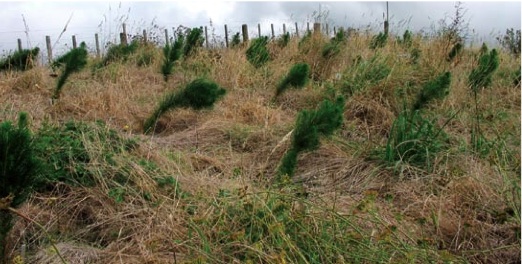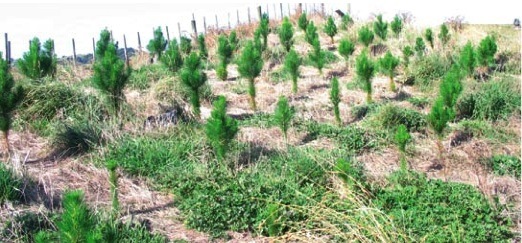Toppling – further advice and insights
Author not published, New Zealand Tree Grower November 2006.
Toppling of young trees is a perpetual problem on some properties, and has been discussed many times in Tree Grower and out at field days. The following contributions, from some two of the Association’s highly experienced members, reflect the fact that there are a number of approaches to dealing with toppling.
A raft of questions: Ted Ramsey
I am concerned that your brief coverage of the toppling problem in the August 2006 Tree Grower leaves a raft of questions and some debatable recommendations. I would like to expand on some aspects of the article.
Leaning or toppling can occur from 12 months on, either from strong winds, excessive top growth in fertile sites or from snow. I agree that poor root anchorage, in wet or plastic soils, is usually the main factor but snow can bend the stem or break roots, even on a firmly anchored tree. Crown lightening can be helpful if you anticipate a potential problem – or have second sight. Because the damage often occurs in patches you have to make the decision to undertake repair work or possibly leave a hole, perhaps leading to poor stocking in your final crop.


For small trees up to two metres tall, propping up with a sod is effective provided the turf is against the trunk to prevent it cutting through during the first heavy rain. But it is essential that you remove all the branches from the top two thirds of the stem. Yes, it will slow the height growth slightly and the trees will look a bit funny until low pruning. However, unless you remove all this top weight, your hard work is likely to be wasted. Tying back to branches of larger trees can be effective but it can be a slow expensive operation.
I agree that cutting off the stem as a last resort is valid, but not with leaving a branch to take over as the leader. These bottom branches are usually quite large and although one will take over, it results in a weak, bent stump up to 50 cm high. I prefer to remove all side branches and then to cut the stem as low as possible, but not below grass height. A mass of epicormic shoots will emerge and you can select the best one next winter. The stump, if less than 50 mm to 60 mm diameter, will be enclosed in a year or two and the height growth of the new stem will amaze you.
The economics of this work can, and will, be debated but in most woodlots you only have to ensure that every second tree has a fair opportunity to become part of the final crop. Finally repair work should be completed before the spring growth starts and the shoots bend up. If you delay too long the wandering pith will remain in the tree for ever and will eventually be discovered by an irate sawmiller.
Additional comments from a Northland perspective: Ingelby Coxe
My experience of toppling is only in Northland, on heavy clay soils. Ted makes some valid points, including drawing attention to the fact that toppling may be a problem as early as 12 months. In Northland we have no experience of snow, although that is a major contributing factor in other parts of the country. Poor planting has been shown to contribute significantly to instability.
On my Waiotira Clay soil, Dean Satchell and Shane Hyde found that releasing cypresses by just trampling down the surrounding vegetation resulted in slower growing but better formed and completely stable trees compared to those in an adjacent spray-released block. This technique did not find favour when mentioned to a forestry consultant, who regarded it as a backward step.
Self correction
Another factor is self correction. An example of this has been that trees planted on my property in August 2005. They were part of a study comparing the growth and stability of trees on the same soil type but with different fertility levels and showed severe toppling following high winds from the north east in late January 2006.
However many had corrected with our prevailing south westerly winds by the time they were measured in August 2006.
Six-month-old trees which toppled with a storm from the north east Self correction by the same trees with the prevailing south west winds.
No joy with remedial measures
My experience with trials on Waiotira clay loam soils to test remedial measures for toppled pines was that no method was satisfactory. I tried turfing, tying, staking, pruning and cutting. Ted raises an interesting idea about the effectiveness of removing all the branches from the top two-thirds of the stem. I wonder if that was tested randomly and in sufficient numbers against alternative methods to result in statistically valid proof? That would make a very interesting research project.
Cutting the stem of toppled trees
The mean root collar diameter of one year old GF 19 radiata pine seedlings treated in a Northland remedial measures trial in 1996 at 12 months was 23 mm, and in trials with 24 month old GF 14 seedlings 78 mm, and GF 26 seedlings 59 mm.
Cutting the stem and leaving a lower branch to become a leader was not successful for me, probably because I straightened the trees from their toppled positions, and also cut the stem too close to the branch, but I have seen undisturbed trees treated successfully in this way by Garth Coulter in Opononi. It is difficult to pick them out in the field now, but none have been harvested yet, so he has no comments to report from the saw miller.
It would be interesting to try Ted’s method of cutting the stem low and selecting one of the developing epicormics, but I wonder whether he has found that they can compete with the untouched trees? Again some trials could prove or disprove the value of this method. I know blanking is not successful a year later to fill in gaps.
Good planting of physiologically aged cuttings on suitable sites is the basis of stability. Peter Davies-Colley’s method of wind proof pruning is a simple, proven and cost effective insurance against toppling. Form pruning done at the same time to remove double leaders will increase the selection potential for the final crop.
It is a sad fact that the tree rotation is of such a length that it is impossible to assess success or failure of many different techniques in time to help others avoid our mistakes.

 Farm Forestry New Zealand
Farm Forestry New Zealand